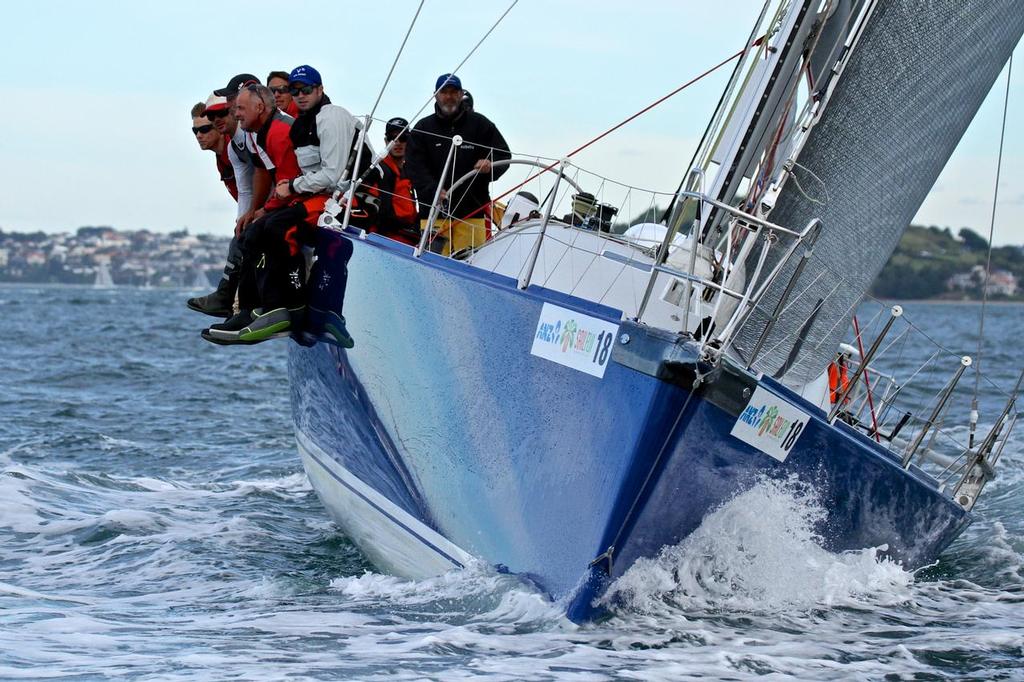ANZ Fiji race- Fifties finish in torrential rain
by Richard Gladwell/Sail-World.com on 13 Jun 2014

Wired - Start ANZ Fiji Race, June 7, 2014 Richard Gladwell
www.photosport.co.nz
Three of the five 50fters finished the ANZ Fiji race early Friday morning having sailed the last stages of the race in heavy rain that at times cut visibility to less than 200metres.
First home in the dark was the David Nathan skippered V5 which finished at: 04:50am, followed over an hour later by the Bakewell-White 52, Wired (Rob Bassett) with Vamos and(Connel McLaren) around 30 mins later.
The three boats had been involved in a 250nm match race, using tactics to outwit each other, and also chasing rain squalls in the convergence zone. The south east trades which normally drive the boats home in the latter stages of this race, did not make an appearance and squall-jumping was the order of the day.
In these conditions, the breezes varied from 0-20kts, with boat speeds varying from stopped to over 14kts. Strongest wind was 40kts about 10kts less than the smaller boats who experienced gusts of 50kts at one stage.
'It was a really interesting race, both tactically and competitively with five 50fters in the event,' V5 skipper David Nathan told Sail-World a couple of hours after finishing at Port Denarau.
This was Nathan's fifth Fiji race and easily the most challenge tactically.
'Our tactical plan was to go west and stay ahead of the front the way the big boats did.
'We had all conditions - except what we were supposed to get - trade winds.
'We were banging away to windward for a few days, and then we started keeping a look out for rain clouds when we got into the convergence zone. We never saw the sun for the whole trip and in those conditions the clouds often look black, but when the wind comes through it can be from the opposite direction from what you'd expect.
Nathan says that the Yellowbrick tracker system is changing yacht racing, as even though the boats are out of physical sight they remain in virtual sight, and the racing is much more tactical as a result.
'We could see Vamos break off to the west, at one stage. But I don't think the move paid off for them, and the fact that they tried the move is interesting. Also having five 50fters in the race makes it much more interesting tactically, as the boats are all so similar in speed, but each has their strong points.'
Even though V5 is a first generation TP52, Nathan doesn't think they are disadvantaged. 'there are five similar sorts of boats. The rule has changed so that the new boats are better on windward leewards, the older ones are better offshore.'
'We didn't get much opportunity to use the canting keel which was a little disappointing as reaching is our strong point,' he added.
All the boats are being regularly modified. The latest changes to V5 involved changes to her canard centreboard and adjustments to their sail wardrobe.'
Olympic Silver medalist and 2013 World 49er champion, Blair Tuke, was one of the helmsmen aboard V5, with his 49er skipper, Peter Burling usually close by and filling a similar function aboard Wired.
'We had everything in terms of weather. We just spent six days going as fast as we could.
'We sailed well for the first two days to get into the convergence zone about 600nm out. But we mucked up in the clouds, and had to restart and catch up.
'We got the boat sailing very fast and began catching up. The key was to have the boat sailing fast and keep looking for the right angles.'
Tuke agreed with his skipper that the Yellowbrick trackers made a big difference to the racing. 'they allow you see what other boats are doing. I learned a lot about tactics, this week,' the Olympic Silver medalist said. 'It is just common sense really,' he added.
'The wind models didn't back up to what we thought we were going to get in a squall,' he said in explanation as to how the boats were often sailing at double the forecasted wind speed, as rain squalls are notoriously difficult for wind modelling to predict.
'We finished in torrential rain and also had some computer issues over the last couple of days,' Tuke said.
'In the heavy rain, we could only see a 200 metres, and we had the squalls throughout the night - not big ones but they would last 90 minutes.'
After catching the other two 50fters, with about a day to go, V5 hit speeds of over 14kts in a particular squall which the other two missed, sailing on at half the boatspeed for that period of an hour or so.
The remainder of the fleet is still at sea. The Cookson 50 Akatea (Gary Lewis) is expected to finish about 24 hours after V5, with the Australian Ker 40 Midnight Rambler (Ed Psaltis) expected to be sixth boat to finish.
The two largest boats in the fleet, Beau Geste and Giacomo finished well ahead of the rest of the fleet and have shared the overall trophies, and taken first and second place in each of the divisions once various handicapping and rating systems are applied.
After suffering forestay damage, the Whitbread maxi Steinlager II was forced to motor to the finish and arrived about 0200hrs on Saturday morning.
If you want to link to this article then please use this URL: www.sail-world.com/123275